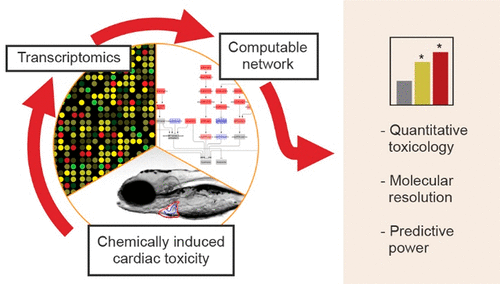当前位置:
X-MOL 学术
›
Chem. Res. Toxicol.
›
论文详情
Our official English website, www.x-mol.net, welcomes your
feedback! (Note: you will need to create a separate account there.)
Systems Toxicology Approach for Testing Chemical Cardiotoxicity in Larval Zebrafish.
Chemical Research in Toxicology ( IF 3.7 ) Pub Date : 2020-07-08 , DOI: 10.1021/acs.chemrestox.0c00095 Roman Li 1, 2 , Anze Zupanic 1 , Marja Talikka 2 , Vincenzo Belcastro 2 , Sumit Madan 3 , Jens Dörpinghaus 3 , Colette Vom Berg 1 , Justyna Szostak 2 , Florian Martin 2 , Manuel C Peitsch 2 , Julia Hoeng 2
Chemical Research in Toxicology ( IF 3.7 ) Pub Date : 2020-07-08 , DOI: 10.1021/acs.chemrestox.0c00095 Roman Li 1, 2 , Anze Zupanic 1 , Marja Talikka 2 , Vincenzo Belcastro 2 , Sumit Madan 3 , Jens Dörpinghaus 3 , Colette Vom Berg 1 , Justyna Szostak 2 , Florian Martin 2 , Manuel C Peitsch 2 , Julia Hoeng 2
Affiliation

|
Transcriptomic approaches can give insight into molecular mechanisms underlying chemical toxicity and are increasingly being used as part of toxicological assessments. To aid the interpretation of transcriptomic data, we have developed a systems toxicology method that relies on a computable biological network model. We created the first network model describing cardiotoxicity in zebrafish larvae—a valuable emerging model species in testing cardiotoxicity associated with drugs and chemicals. The network is based on scientific literature and represents hierarchical molecular pathways that lead from receptor activation to cardiac pathologies. To test the ability of our approach to detect cardiotoxic outcomes from transcriptomic data, we have selected three publicly available data sets that reported chemically induced heart pathologies in zebrafish larvae for five different chemicals. Network-based analysis detected cardiac perturbations for four out of five chemicals tested, for two of them using transcriptomic data collected up to 3 days before the onset of a visible phenotype. Additionally, we identified distinct molecular pathways that were activated by the different chemicals. The results demonstrate that the proposed integrational method can be used for evaluating the effects of chemicals on the zebrafish cardiac function and, together with observed cardiac apical end points, can provide a comprehensive method for connecting molecular events to organ toxicity. The computable network model is freely available and may be used to generate mechanistic hypotheses and quantifiable perturbation values from any zebrafish transcriptomic data.
中文翻译:

用于测试斑马鱼幼虫化学心脏毒性的系统毒理学方法。
转录组学方法可以深入了解化学毒性的分子机制,并且越来越多地被用作毒理学评估的一部分。为了帮助解释转录组数据,我们开发了一种依赖于可计算生物网络模型的系统毒理学方法。我们创建了第一个描述斑马鱼幼虫心脏毒性的网络模型 - 一种用于测试与药物和化学品相关的心脏毒性的有价值的新兴模型物种。该网络基于科学文献,代表了从受体激活到心脏病变的分级分子通路。为了测试我们的方法从转录组数据中检测心脏毒性结果的能力,我们选择了三个公开可用的数据集,这些数据集报告了斑马鱼幼虫中五种不同化学物质的化学诱导心脏病变。基于网络的分析检测到测试的五种化学物质中的四种的心脏扰动,其中两种使用在可见表型出现前 3 天收集的转录组数据。此外,我们确定了由不同化学物质激活的不同分子途径。结果表明,所提出的集成方法可用于评估化学物质对斑马鱼心脏功能的影响,并与观察到的心尖终点一起提供一种将分子事件与器官毒性联系起来的综合方法。
更新日期:2020-07-08
中文翻译:

用于测试斑马鱼幼虫化学心脏毒性的系统毒理学方法。
转录组学方法可以深入了解化学毒性的分子机制,并且越来越多地被用作毒理学评估的一部分。为了帮助解释转录组数据,我们开发了一种依赖于可计算生物网络模型的系统毒理学方法。我们创建了第一个描述斑马鱼幼虫心脏毒性的网络模型 - 一种用于测试与药物和化学品相关的心脏毒性的有价值的新兴模型物种。该网络基于科学文献,代表了从受体激活到心脏病变的分级分子通路。为了测试我们的方法从转录组数据中检测心脏毒性结果的能力,我们选择了三个公开可用的数据集,这些数据集报告了斑马鱼幼虫中五种不同化学物质的化学诱导心脏病变。基于网络的分析检测到测试的五种化学物质中的四种的心脏扰动,其中两种使用在可见表型出现前 3 天收集的转录组数据。此外,我们确定了由不同化学物质激活的不同分子途径。结果表明,所提出的集成方法可用于评估化学物质对斑马鱼心脏功能的影响,并与观察到的心尖终点一起提供一种将分子事件与器官毒性联系起来的综合方法。











































 京公网安备 11010802027423号
京公网安备 11010802027423号